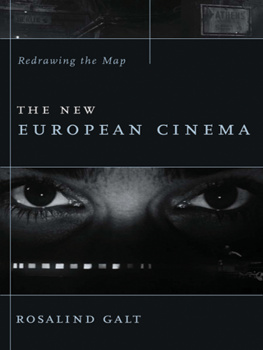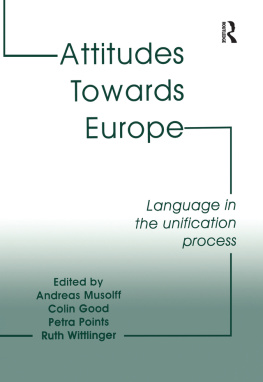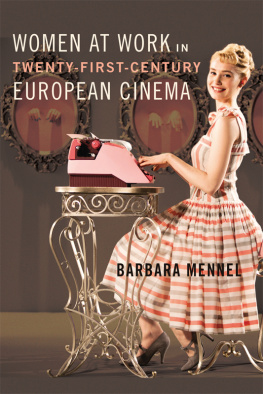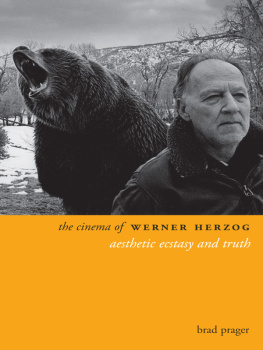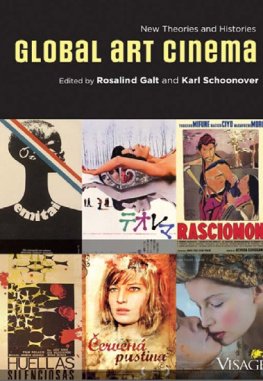THE NEW EUROPEAN CINEMA
Film and Culture
FILM AND CULTURE
A SERIES OF COLUMBIA UNIVERSITY PRESS
EDITED BY JOHN BELTON
What Made Pistachio Nuts? Early Sound Comedy and the Vaudeville Aesthetic
Henry Jenkins
Showstoppers: Busby Berkeley and the Tradition of Spectacle
Martin Rubin
Projections of War: Hollywood, American Culture, and World War II
Thomas Doherty
Laughing Screaming: Modern Hollywood Horror and Comedy
William Paul
Laughing Hysterically: American Screen Comedy of the 1950s
Ed Sikov
Primitive Passions: Visuality, Sexuality, Ethnography, and Contemporary Chinese Cinema
Rey Chow
The Cinema of Max Ophuls: Magisterial Vision and the Figure of Woman
Susan M. White
Black Women as Cultural Readers
Jacqueline Bobo
Picturing Japaneseness: Monumental Style, National Identity, Japanese Film
Darrell William Davis
Attack of the Leading Ladies: Gender, Sexuality, and Spectatorship in Classic Horror Cinema
Rhona J. Berenstein
This Mad Masquerade: Stardom and Masculinity in the Jazz Age
Gaylyn Studlar
Sexual Politics and Narrative Film: Hollywood and Beyond
Robin Wood
The Sounds of Commerce: Marketing Popular Film Music
Jeff Smith
Orson Welles, Shakespeare, and Popular Culture
Michael Anderegg
Pre-Code Hollywood: Sex, Immorality, and Insurrection in American Cinema, 19301934
Thomas Doherty
Sound Technology and the American Cinema: Perception, Representation, Modernity
James Lastra
Melodrama and Modernity: Early Sensational Cinema and Its Contexts
Ben Singer
Wondrous Difference: Cinema, Anthropology, and Turn-of-the-Century Visual Culture
Alison Griffiths
Hearst Over Hollywood: Power, Passion, and Propaganda in the Movies
Louis Pizzitola
Masculine Interests: Homoerotics in Hollywood Film
Robert Lang
Special Effects: Still in Search of Wonder
Michele Pierson
Designing Women: Cinema, Art Deco, and the Female Form
Lucy Fischer
Cold War, Cool Medium: Television, McCarthyism, and American Culture
Thomas Doherty
Katharine Hepburn: Star as Feminist
Andrew Britton
Silent Film Sound
Rick Altman
Home in Hollywood: The Imaginary Geography of Hollywood
Elisabeth Bronfen
Hollywood and the Culture Elite: How the Movies Became American
Peter Decherney
Taiwan Film Directors: A Treasure Island
Emilie Yueh-yu Yeh and Darrell
William Davis
Shocking Representation: Historical Trauma, National Cinema, and the Modern Horror Film
Adam Lowenstein
China on Screen: Cinema and Nation
Chris Berry and Mary Farquhar
THE NEW
EUROPEAN
CINEMA
Redrawing the Map
Rosalind Galt
Columbia University Press
New York
Columbia University Press wishes to express its appreciation for assistance given by the University of Iowa for the publication of this book.

Columbia University Press
Publishers Since 1893
New York Chichester, West Sussex
cup.columbia.edu
Copyright 2006 Columbia University Press
All rights reserved
E-ISBN 978-0-231-51032-5
Library of Congress Cataloging-in-Publication Data
Galt, Rosalind.
The new European cinema : redrawing the map / Rosalind Galt.
p. cm.(film and culture)
Includes bibliographical references and index.
ISBN 0-231-13716-8 (cloth : alk. paper)
ISBN 0-231-13717-6 (pbk. : alk. paper)
ISBN 0-231-51032-2 (electronic)
1. Motion picturesEurope. I. Title. II. Series.
PN1993.5.E8G35 2006
791.43094dc22
2005033601
A Columbia University Press E-book
CUP would be pleased to hear about your reading experience with this e-book at .
Acknowledgment is gratefully made for permission to reproduce stills from Underground to CIBY DA/PANDORA/1995.
Contents
Many people have helped shape this book. Mary Ann Doane, Philip Rosen, and John Caughie were invaluable readers during the early stages of the project, while Corey Creekmur and Sasha Waters Freyer offered detailed and insightful commentary on later versions. Nicole Rizzuto read drafts tirelessly and offered both editorial insight and intellectual inspiration. With Karl Schoonover, Kerry Herman, Rebecca Wingfield, Chris Cagle, and Kirsten Ostherr, I debated film theory, feminism, and art history. This project developed in dialogue with their work, and I hope it bears some traces of their brilliance. Friends, teachers, and colleagues who have contributed ideas, criticism, and support include Neil Lazarus, Ellen Rooney, Massimo Riva, Rda Bensmaa, Loren Noveck, Paul Haacke, Mette Hjort, Angela dalle Vacche, Dudley Andrew, Steve Ungar, Rick Altman, Louis Schwartz, Kathleen Newman, Lisa Collins, Jessica Levin, and Evelyn So. Claudia Pmmer helped with research and formatting, and Anastasia Saverino worked on the index. from the anonymous readers at Cinema Journal who reviewed a shorter form of the argument. Thanks also go to the readers for Columbia University Press, who offered productive suggestions for revision. Last but by no means least, this project has gained tremendously from discussions with my students over the years.
In tracking down film prints, Richard Manning at Brown University was a stellar resource and a gonzo movie god. Also helpful were the staff at the Museum of Modern Art (MoMA) Film Study Center, the New York Public Library, the Donnell Library, and the British Film Institute. Staff at the University of Iowas library provided technical and research assistance. Some films proved difficult to locate, and here I received help from Ellen Elias-Bursac, Radmila Gorup, and Vitaly Chernetsky. Misha Nedeljkovi kindly sent me tapes of some rare Yugoslav films and in addition offered readings, advice, and historical perspective. Thanks also to filmmakers Bettina Ellerkamp and Jrg Heitman, who graciously shared their work with me. Thanks also go to all at Columbia University Press, especially Irene Pavitt, Cynthia Garver, and Juree Sondker.
Parts of were published as Back Projection: Visualizing Past and Present Europe in Lars von Triers Zentropa, Cinema Journal 45, no. 2 (2005).
Finally, I want to thank those closest to me for their love and support: Adrian Goycoolea, who, in addition to sharing my life, spent countless hours on this project preparing frame stills; my mother, who was my first role model as a feminist and cultural critic; and my late father. My father instilled in me a love of Italian landscape and culture, with which came a foundational narrative of leftist loss. He served in Italy in World War II and returned with our family year after year as a tourist and student of Italian. I could not have formulated my reading of the Italian political landscape without his memory.
In the early 1990s, Europe became, as if it had not been so before, a question of space. The fall of the Berlin Wall in 1989, the breakup of the Soviet Union, the break-down of Yugoslavia, and the unification of Germany produced radical upheavals in every aspect of European life, but most urgently, they made a collective demand on an idea of Europe as a psychic, cultural, or geopolitical location. For the first time since the end of World War II, the borders of Europe were disconcertingly unstable. Through the 1990s, this traumatic overturning of spatial categories was augmented with a more gradual, although by no means painless, redefinition: the expansion of the European Union to include members and potential members as far apart as Finland, Bulgaria, and Turkey. It is clear that as the physical and political territory of Europe altered in the postCold War years, so, too, did its cultural imaginary. What is less clear is how we can read these changes cinematically: how European cinema represented revisions of European space narratively, formally, and stylistically, and, indeed, how the terrain of European cinema itself was acted on by the forces that were reshaping the continent.
Next page
